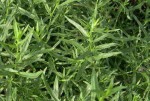 For me, tarragon is an illusive herb; it comes and goes in my zone 7 garden with a mind of its own. I keep replacing it, but lose it rather quickly and have to start all over again. I bought my first plant from Well Swept Nursery in New Jersey. It was French tarragon (Artemisia dracunculus), a perennial, and it disappeared in winter as expected but never reappeared. Since I like putting it in soup during the winter I tried the substitute, mint marigold (Tagetes lucida), that is very tender but can be grown indoors on a windowsill during the short cold days of winter and give me a constant supply of leaves. It quickly became pot bound and ultimately bit the dust. Next I went to the local farmers’ market and bought a new tarragon plant that was “guaranteed” to be French tarragon but turned out to be its much less tasty cousin, Russian tarragon (Artemisia dracunculoides). Oh well, it’s a bit hardier and tougher than the French species and has lasted for several years in a pot outside my kitchen door, although it is dreadfully pot bound right now.
For me, tarragon is an illusive herb; it comes and goes in my zone 7 garden with a mind of its own. I keep replacing it, but lose it rather quickly and have to start all over again. I bought my first plant from Well Swept Nursery in New Jersey. It was French tarragon (Artemisia dracunculus), a perennial, and it disappeared in winter as expected but never reappeared. Since I like putting it in soup during the winter I tried the substitute, mint marigold (Tagetes lucida), that is very tender but can be grown indoors on a windowsill during the short cold days of winter and give me a constant supply of leaves. It quickly became pot bound and ultimately bit the dust. Next I went to the local farmers’ market and bought a new tarragon plant that was “guaranteed” to be French tarragon but turned out to be its much less tasty cousin, Russian tarragon (Artemisia dracunculoides). Oh well, it’s a bit hardier and tougher than the French species and has lasted for several years in a pot outside my kitchen door, although it is dreadfully pot bound right now.
French tarragon is difficult to grow from seed because most of its flowers are sterile. The commercially available French tarragon is reproduced by cuttings and division and is therefore less available and more pricey than Russian tarragon. Both disappear in winter so if you want a supply of leaves for winter use try freezing them or preserving them in vinegar as their flavor declines in the drying process.
The French consider tarragon one of the fines herbes along with chervil, parsely, and chives. They use it in their famous béarnaise sauce, remoulade sauce, tartar sauce, salad dressing, and veal Marengo. I use it with chicken, especially in chicken salad, and to enhance a can of tomato soup . For best flavor, add tarragon at the end of the cooking time because heat is detrimental to its flavor.
Many garden pests find the scent and taste of tarragon objectionable so it makes a good companion plant. In addition, it is said to enhance the flavor of nearby plants and aid their growth.
Type: Perennial herb.
Bloom: Small yellow or greenish white flowers are produced in terminal clusters in summer.
Leaves: Linear to lanceolate, simple; 1-4” long.
Size: 2-3’ H x 2-3’ W (Russian tarragon larger than French)
Light: Full sun to partial shade.
Soil: Average, well drained; avoid acid and wet soils.
Fertilizer: Apply composted manure in spring.
Hardiness: Zones 3-7.
Care: Mulch in winter to protect from frost; divide every 2-3 years.
Pests and Diseases: Root rot and mildew can be a problem in wet humid conditions.
Propagation: French-cuttings, divisions; Russian-seed, cuttings, divisions.
